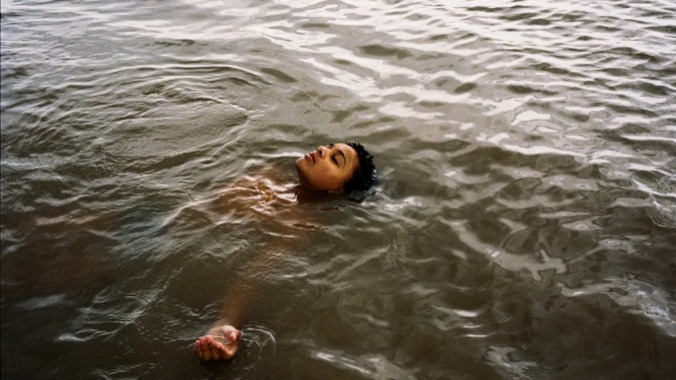Andrea Arnold’s Fairy Tale Bird Blends Brutality with Transcendence

From the council estate-set Fish Tank to American Honey‘s scrappy road trip via grubby motels, Andrea Arnold’s movies are often gritty kitchen-sink dramas taking place against even grimier backdrops, from which she nevertheless unearths sublime beauty. At first glance, Arnold’s Bird seems to be set firmly within this tradition: It follows another marginalized young woman (Bailey, played by non-professional actor Nykiya Adams), who lives in a ramshackle squat with her father Bug (Barry Keoghan) and half-brother Hunter (Jason Buda). But Bird also marks a clear stylistic departure for Arnold. This film is both more raw and more fantastical than her previous works, existing on spectrum extremes in a way her other films haven’t.
In the summer during which the movie is set, tween Bailey teeters on the cliff-edge between childhood and adolescence. She gets her period, experiments with heavy eyeliner and bold new hairstyles and longs to hang out with the older kids, who are waging a vigilante-style campaign against local reprobates (“making the world better one cunt at a time” is the gang’s motto). But in other ways, Bailey is already prematurely grown up. When her happy-go-lucky father Bug (appropriately named, because Keoghan is tatted up like an entomology textbook) suddenly announces he’s marrying his girlfriend of only a few months, Bailey reacts with a weary skepticism that suggests the usual dynamics have long been reversed for this parent and child. That’s echoed in the fiercely protective, quasi-parental role she adopts over her three younger siblings, who live nearby with their troubled mother (Jasmine Jobson) and her deeply unpleasant boyfriend Skate (a terrifying James Nelson-Joyce).
It’s in the scenes at Bailey’s mother’s house where Arnold reaches brutal new extremes. Though her films have never shied away from darkness, Skate’s presence is perhaps the most thickly malevolent of any in her filmography; it’s volatile and nasty, a powder keg threatening to explode in a tiny terraced house. With her mother under his thumb, it’s Bailey who movingly speaks up for the interests of her young siblings and refuses to be cowed by Skate’s tyranny—a remarkable feat, not least because it’s hard to imagine mustering such strength even when Nelson-Joyce is confined to the safety of our screens.
But Bird isn’t really a human monster movie. It’s a fairy tale. Just as Arnold amps up the harshness, she also reaches beyond the limits of her traditional realism with a transcendent twist in the form of Franz Rogowski’s Bird. Sporting a skirt and an unplaceable accent, the childlike Bird arrives in Bailey’s life with a hazy backstory (he’s “looking for his family”). Bailey has a filmmaker’s reflex—the movie often splices in the wonderstruck videos she takes of local wildlife—and so she initially treats this strange figure with appropriate suspicion, pulling out her phone to film their first meeting for safety. But she soon softens once she identifies something pure and gentle in Bird’s eccentricity. Able to really see her in ways no one else does, Bird feels like a holy innocent in whom the worldly Bailey can nevertheless still recognize parts of her young self.
It’s through Rogowski’s ethereal presence that Bird takes flight into magical realism, though Arnold makes the evolution slowly. Initially, the strangest thing in Bird is Bug’s madcap money-making scheme, which sounds like the kind of phenomenon you’d see chronicled in a VICE doc short in 2015: He plans to extract and sell the hallucinogenic secretions of a “drug toad,” a process achieved by playing the toad’s favorite music (a detail that gives rises to a seemingly serendipitous Saltburn gag). Psychedelic slime aside, Bird is firmly grounded in reality up to this point, but when Bird arrives, Arnold begins to hint at a stylistic transfiguration via sound (strange ruffling noises seem to emerge from his arms when he’s emotional) before events become outright fantastical.